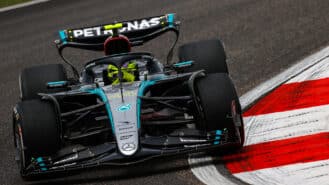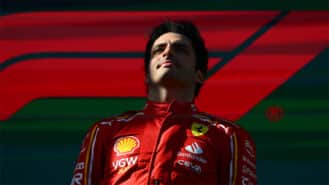
Hamilton moans earn him F1 highlights reel – Up/Down in China
The king of positive vibes has seen his crown slipping recently – a grey day in China only deepened the Silver Arrows' Slough of Despond
Quietly over the weekend, Aston Martin unveiled a new concept at Villa D’Este called the AM310. So what, you might ask.
A concept it might be but it might just be the most important new car Aston Martin has shown since it launched the DB9 in 2004 when it effectively launched the marque into the modern era. This is because the AM310 is believed to be the new DBS in all but name, and the new DBS is the car that upon which the next generation of Astons will be based.
To date Aston Martin has proved both resilient and imaginative in its efforts to keep its current product line-up up to date. Beneath every Aston made today (save the special-case, Veyron-rivalling One-77) is the same platform used in the original DB9. It has suited Aston’s purposes because it was designed to be stretched to make a four door Rapide or abbreviated to make a V8 Vantage. It is a hugely flexible architecture that has served Aston’s high quality, low volume market positioning very well.
But it has two problems. Despite being an all-aluminium chassis, it’s not very light. A base spec V8 Vantage is a colossal 250kg heavier than the equivalent Porsche 911, despite not having any rear seats. This makes the car slower and thirstier than it needs to be: the 911 does 31.4mpg, the Aston just 20.5mpg, meaning the Porsche will go more than half as far again on a gallon of fuel, yet their performance is all but identical.
The perhaps less important issue is that the design is not terribly space efficient: I’m 6ft 4in so am admittedly at the tall end of the spectrum, but my height is not freakish and I’ve always struggled to find enough leg room in any modern Aston.
Nothing as yet is known about how the DBS will address these issues, though address them it must, particularly when it comes to losing weight. Even among luxury and supercar manufacturers the tide has finally and decisively turned against the menace of weight gain. Time was when we were impressed when a new generation of car was only slightly heavier than the one before, because they always had more kit to carry. No longer: it’s not just Porsches that are fighting the flab: even Bentleys are getting lighter.
Yet it seems unlikely that Aston Martin has developed an all-new platform by itself. Like its Gaydon factory, the last platform was paid for by its then parent Ford and as there’s been no word of any platform-sharing joint venture with a large manufacturer, it’s a fair assumption that whatever Aston does, it will involve improving what it already has rather than starting again.
So my finger in the air guess is that the DBS will feature a revised version of the existing platform, with extensive use of carbon fibre in place of aluminium to improve rigidity and save weight. Since the day of the DB9, carbon fibre has become both cheaper and easier to use. I also expect a completely new interior and, I hope, dials that at last will do more than look nice and actually be reasonably legible.
Which leaves the engine. Both the big V12 used by the DB9, DBS and Rapide and the smaller V8 found in the Vantage are still built in a dedicated Aston Martin facility in the corner of a Ford factory in Cologne. Neither engine is exactly young anymore and both are profligately thirsty.
But so too are they the very essence of Aston Martin. While the company continues to use engines that sound as good, pull as hard and stir the soul as well as these, there will always be a reason to choose an Aston over anything else. No doubt more power and better consumption could be had by buying in smaller capacity turbo units, but at what price? I hope and expect that the old engines, however modified, will be retained.
There is no doubt that Aston Martin needs to inject some fresh life into its model ranges: there are only so many special editions you can produce while retaining your credibility. The tricky balance Aston has to strike is to convince the world the DBS and those that will follow it are genuinely new and state of the art while, at the same time, retaining all those traditional Aston values that built the brand in the first place. All these questions will be answered when the production specification DBS is formally unveiled this autumn.

The king of positive vibes has seen his crown slipping recently – a grey day in China only deepened the Silver Arrows' Slough of Despond

In the face of soul-destroying boredom, only one driver can bring the entertainment needed to rescue a sport which resembles a broken AI tribute to itself

Waking up at 4am on a Sunday is rarely worth it, especially when Max Verstappen looks poised to take another lights out to chequered flag victory — as he did…

Should there be a new prize for a team finishing sixth in the championship – just like the Jim Clark Trophy in the good old turbo times?